英语中的名词副词形容词
英语文法基础:名词、动词、形容词、副词、介词、连词、代词的定义

英语文法基础:名词、动词、形容词、副词、介词、连词、代
词的定义
1. 名词:包括专有名词、普通名词和集合名词,需要注意可数名词与不可数名词,以及存在复数形式变化。
2. 动词:包括动词原形、过去式、过去分词和现在分词。
需要注意谓语动词的人称和数的变化,以及不规则动词的变化。
3. 形容词:常用的有级形容词、比较级形容词和最高级形容词。
需要注意其定义词语和搭配用法。
4. 副词:修饰动词、形容词或其他副词,常用来表达时间、程度、频率等。
需要注意副词的正确使用和搭配。
5. 介词:表示位置、方向和关系的词语,常见的有基本介词和固定短语介词。
需要注意其正确使用方法。
6. 连词:用于连接句子成分的词语,常见的有并列连词、因果连词和递进连词等。
需要注意其紧凑表达的特点。
7. 代词:用于替换名词和代替句子成分的词语,常见的有人称代词、物主代词和指示代词等。
需要注意其正确使用及变化形式。
另外,除了上述的词汇基础以外,还要注意句子的结构,加强语法的理解和运用,例如:
1. 动宾关系:主动词一般和及物动词相搭配,主表结构中的主语一般跟谓语动词构成谓语,而被动词则需要搭配助动词be。
2. 时态:掌握各个时态的正确使用和选择,并能熟练运用它们。
3. 从句:包括主语从句、宾语从句、表语从句和同位语从句等,需要注意语序和连接词的选择。
4. 语气:根据句子的不同结构,采用不同语气来表达,例如祈使句是用来做命令性指示的,因此要用肯定语气。
英语单词常见的词性

英语单词常见的词性
在英语中,单词可以根据它们在句子中所扮演的角色被划
分为不同的词性。
掌握英语单词的常见词性对于理解和运用语言至关重要。
下面将介绍英语中单词的几种常见的词性:
名词(Noun)
名词是用来表示人、事物、地点、抽象概念等的词类。
在
句子中,名词通常用来作为主语、宾语或是表语。
动词(Verb)
动词是表示动作、状态或者是事件发生的词类。
在句子中,动词用来表达主语的动作或状态。
形容词(Adjective)
形容词是用来修饰名词或代词的词类,描述人、事物的性
质或特征。
形容词常常位于名词之前。
副词(Adverb)
副词是用来修饰动词、形容词或其他副词的词类,多数副
词通常用来表示程度、时间、地点或方式。
代词(Pronoun)
代词是用来替代名词或名词短语的词类。
代词可以代替特
定的人、事物或概念。
介词(Preposition)
介词是用来表达名词或代词与其他词之间的关系的词类。
介词通常用来连接名词或代词与其他句子成分。
连词(Conjunction)
连词是用来连接词、短语或句子的词类。
连词分为并列连词和从属连词,用来连接不同的句子成分。
冠词(Article)
冠词是用来限定名词的词类,分为定冠词(the)和不定冠词(a、an)。
以上便是英语中单词常见的几种词性。
掌握这些词性的基本概念,将有助于更准确、流利地使用英语进行表达。
希望这些信息能帮助您更好地理解英语语言中的单词词性。
英语名词动词形容词等词语词性分类

精品PPT
英语词语分类
•英语的词通常分为十大类 即名词、冠词、代词、数词、形容词、副词、 动词、介词、连词和感叹词。
精品PPT
(一)名词(noun)
•名词(noun)是表示人、事物、地点或抽象概念 的名称。——缩写为n
•例如: Zeng Xiaoxian(曾小贤) orange (橙子) Beijing (北京) morning(早晨) peace( 和平 )
例如:good好的 red红的 beautiful 美丽的 good boy好男孩 red book 红色的书 beautiful flower美丽的花
精品PPT
动词
• 就是用来形容或表示各类动作或状态的 词汇。也可以解释为事物可以产生的行 为——缩写为v
• • 1、有的动词表示一般的动作,如"come
来、run跑、fly起飞、open打开、认识、 吼、叫、学习、"等.
精品PPT
• 2、有的动词表示心理活动,如" like喜 欢 、think想、know知道、can能够、 注重、尊敬、了解、相信、佩服、惦 念"等
• "is是""have有"等也是动词,跟动词的 用法一样,“是”也称为判断动词
精品PPT
词语归类小练习
• blue 蓝色的、sky 天空、meet 遇 见、these 这些、zoo动物园、 help 帮助、it它、monday 星期一、 short 短的、have 有、south 南 方、cry 哭、her 她的、cold 冷的、 myself我自己、get 得到 、 food 食物 、who谁、are是、 Bank 银行、new 新的、sleep 睡觉、 it它、what什么精、品PPT
英语词类名词动词形容词副词介词
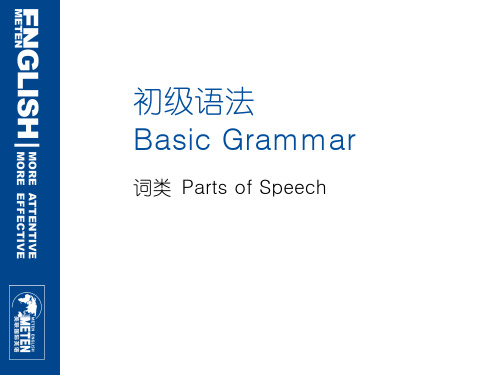
3. 词类的转换
一个词类常可能转换为另一词类:
1. 某些动词可以转换为名词:
Try the shirt on. 穿上这件衬衫试试(v. ) Let me have a try.我来试一试。(n. ) Look at me. 瞧着我。(v. ) Let me have a look.我来瞧瞧。(n. )
8.介词(用在名词、代词等前面,说明与别的词之间关系) - prep. ( preposition ) in, on, from, through, for
9.连词(连接词与词或句与句) - conj. ( conjunction )and, or, if, when, although 10.感叹词(表示说话时的感情或口气) - int. ( interjection ) ah, well, wow, why 不定式前的to为小品词(particles)。yes和no 有人称为肯定词和 否定词,有的词典称之为副词。
2. 某些名词也可转换为动词: Open your books.打开你的书。(n. ) Have you booked your ticket?你订票了吗?( ) The hall seats 500 ( people ).大厅可以坐500 人。(v. )
3. 某些形容词可以转换为动词: You are too slow.你太慢了。(adj. ) The train has slowed down.火车慢下来了。(v. ) It’s warm in spring.春天天气暖和。(adj. ) They warmed their hands over the fire.他们在炉火上烤手。(v. )
答案: 1. n 2. v 3. adv 4. pron 5. adj 6. num 7. v 8. adj 9. prep 10. n
英语之中名词、代词、动词、形容词、冠词、数词、副词、介词、连词、感叹词

(一)之袁州冬雪创作1、名词名词 (Nouns)是词性的一种,也是实词的一种,是指待人、物、事、时、地、情感、概念等实体或抽象事物的词. 名词可以独立成句.在短语或句子中通常可以用代词来替代.2、代词是代替名词的一种词类.大多数代词具有名词和形容词的功能.英语中的代词,按其意义、特征及在句中的作用分为:人称代词、物主代词、指示代词、自身代词、相互代词、疑问代词、关系代词和不定代词八种.3、动词,就是用来形容或暗示各类动作的词汇.基本上每一个完整的子句都有一个动词,要暗示第二个动作时可以使用不定词、动名词、对等毗连词、从属毗连词或增加子句等方法保持.根据其在句中的功能,动词可分为四类.4、形容词形容词【adjective】很多语言中均有的主要词类中的一种.主要用来修饰名词的词,暗示事物的特征5、冠词的定义冠词是置于名词之前,对名词起限制作用的一种虚词.冠词可以说是名词的一种标记,它不克不及分开名词而独立存在.冠词的分类冠词分为不定冠词"a,an"、定冠词"the"和零冠词三种6、数词暗示"多少"和"第几"的词,叫数词.其用法相当于名词或者形容词.数词分为基数词和序数词两种.暗示数目多少或顺序多少的词叫数词,数词分为基数词和序数词.7、副词(Adverb)副词的定义: 副词是一种用来修饰动词,形容词,副词或全句的词,说明时间,地点,程度,方式等概念.8、介词的定义和特征介词是一种用来暗示词与词, 词与句之间的关系的词.在句中不克不及单独作句字成分.介词后面一般有名词代词或相当于名词的其他词类,短语或从句作它的宾语.(二)1、名词,人或事物的称号3、代词,代替名词或者数词(比方some就是代替数目)3、动词,动作或状态4、数词,暗示数目或顺序(比方序数词,5th就是暗示顺序)5、形容词,人或事物的性质或状态(因为形容词一般修饰名词)6、副词,动作的特征或性状特征(因为副词一般修饰动词或形容词)7、冠词,暗示名词的泛指或特指8、介词,暗示名词或代词与其他词的关系(因为介词后面一半紧跟名词,代词或其他名词性布局)9、连词,毗连词与词,短语与短语,句子与句子10、感叹词,暗示说话时的感情或语气(三)1、adj. / a. 形容词用来描绘一类物质的性质,状态,外貌,或人的性格特点,性质,品格如:big,happy2、adv. / ad. 副词用来修饰动作或形容词,一般在句子中做状语用暗示动作的停止怎样,或暗示程度,特点,如:clearly,happily3、prep. 介词毗连地点,时间的一类词语,可以暗示方位,时间.跟一些暗示时间,地点的词连用暗示介词词组如:in,to,on,under4、conj. 连词用来毗连时间,地点,原因,成果的一类词语如:when,beacuse,so5、num. 数词暗示数字的词,既可以是基数词,也可以是序数词如:one,two,first6、int. 感叹词暗示感叹的一类词,一般不加一诠释,只代表感叹如:what,how,haurray7、vt. 及物动词(后面要加宾语)行为动作的词如:do,finish,play8、vi. 不及物动词(后面不加宾语)暗示行为动作的词如:appear9、n. 名词暗示物体,物质的词如:pig,cow,man10、pron. 代词代指一类人,事或物的词如:he,she,hers,his,things11、art = 冠词,article的缩写(四)在英语语法中主要把词分为8大类:1.名词:暗示人、物或地方等,如:John,teacher;table,pen;London;beauty.2.代词:用来代替名词,以防止重复某个名词,如:I,you,it,that,those,them.3.形容词:用来修饰或限制某个(些)名词,如:good(man),white(paper),every(book),much(water),(John is)hon-est,(He seems)lazy.被修饰或限制的名词,叫做主体词(head-word).4.动词:暗示行为或状态,如:speak,read,go,think,is,seem.5.介词:暗示它后面的名词(或代词)跟它前面的动词、另外一名词或形容词的关系.这些名词(或代词)称为介词的宾语.介词宾语和介词构成介词短语.He went to school.(介词to把名词school和动词went接洽起来)He stood by me.He asked for it.The book on the desk is mine.(介词on把名词book和另外一名词desk接洽起来)He lives in a house on the mountain.他住在山上的一幢房子里.The bridge across this river is built by a Frenchman.河上的桥是一位法国人修建的.He is sure of it.他对此很有掌控.(of接洽it和sure.)It is good for you.这对你有好处.He is angry with Mary.他生玛丽的气.6.副词:修饰或限制动词、形容词或其他副词,甚至介词、连词及整个句子.He walked slowly.他走得很慢.He did it carefully.他干得很仔细.He is a very kind man.他是一个非常善良的人.John is truly honest.约翰的确很诚实.He arrived too late.他到得太晚了.He walked rather slowly.他走得相当慢.He sat far behind me.他坐在我后面挺远的地方.He arrived exactly at seven.他在7点整到达.He will come probably after we take lunch.他能够在我们吃午饭之后到达.He loves her just because she is pretty.他爱她只是因为她漂亮.Luckily,he got back his money.幸好他把钱要回来了. Historically,China is a great nation.从汗青上看中国是个伟大的国家.7.连词:用来毗连词、词组(短语)或句子,如:and,but,or,so;或把一个句子和一动词或名词接洽起来,如:when,because,as,though,that.(连词and把Hong Kong He visited Hong Kong and Singapore.和Singapore毗连起来)他访问了香港和新加坡.She is pretty but cruel.她很漂亮却很残暴.He does exercise in class or at home.他在讲堂上或是在家里做操练.(or把in class和at home两个短语毗连起来)She sat by me,reading novels but turning her eyes tochildren about her from time to time.她坐在我身旁看小说,但不时把眼睛转向她周围的孩子们.He works hard,so he will succeed.他很尽力,所以他会成功.(so把he works hard和he will succeed毗连起来)He says this and that,but he does not mean them.他说这说那,但这些都不是他的真心话.He was writing when it was rainning.下雨时他正在写作.(when把动词was raining和he was writing毗连起来)He became a beggar because he had been a gambler.他成了乞丐因为他爱赌博.He went to school though he was sick.他虽病了,但他仍然上学.The news that the enemy had surrendered soon reached us.不久传来了敌人投降的消息.8.感叹词:用来暗示说话时的感情,如Oh!,Alas!,My!上面只是对8大词类粗略的诠释.别的冠词、数词也可算作两个词类,冠词只有a,an,the3个字,数词可归入形容词中.。
英语中的名词副词形容词
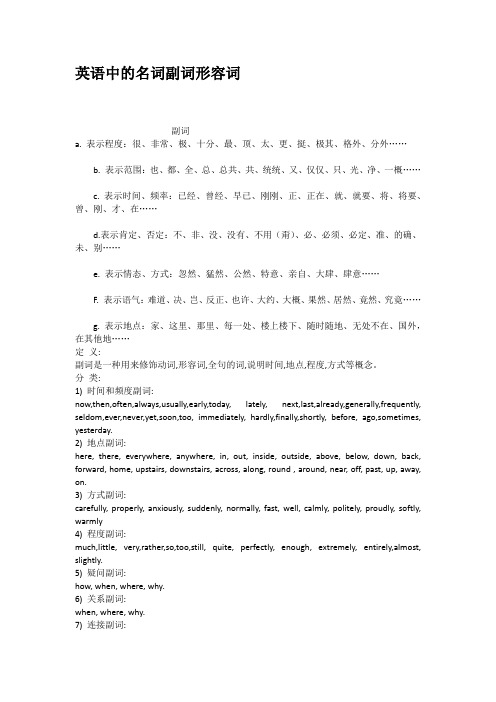
英语中的名词副词形容词副词a. 表示程度:很、非常、极、十分、最、顶、太、更、挺、极其、格外、分外……b. 表示范围:也、都、全、总、总共、共、统统、又、仅仅、只、光、净、一概……c. 表示时间、频率:已经、曾经、早已、刚刚、正、正在、就、就要、将、将要、曾、刚、才、在……d.表示肯定、否定:不、非、没、没有、不用(甭)、必、必须、必定、准、的确、未、别……e. 表示情态、方式:忽然、猛然、公然、特意、亲自、大肆、肆意……F. 表示语气:难道、决、岂、反正、也许、大约、大概、果然、居然、竟然、究竟……g. 表示地点:家、这里、那里、每一处、楼上楼下、随时随地、无处不在、国外,在其他地……定义:副词是一种用来修饰动词,形容词,全句的词,说明时间,地点,程度,方式等概念。
分类:1) 时间和频度副词:now,then,often,always,usually,early,today, lately, next,last,already,generally,frequently, seldom,ever,never,yet,soon,too, immediately, hardly,finally,shortly, before, ago,sometimes, yesterday.2) 地点副词:here, there, everywhere, anywhere, in, out, inside, outside, above, below, down, back, forward, home, upstairs, downstairs, across, along, round , around, near, off, past, up, away, on.3) 方式副词:carefully, properly, anxiously, suddenly, normally, fast, well, calmly, politely, proudly, softly, warmly4) 程度副词:much,little, very,rather,so,too,still, quite, perfectly, enough, extremely, entirely,almost, slightly.5) 疑问副词:how, when, where, why.6) 关系副词:when, where, why.7) 连接副词:how, when, where, why, whether.用法:副词在句中可作状语,表语,补语。
英语之中名词、代词、动词、形容词、冠词、数词、副词、介词、连词、感叹词
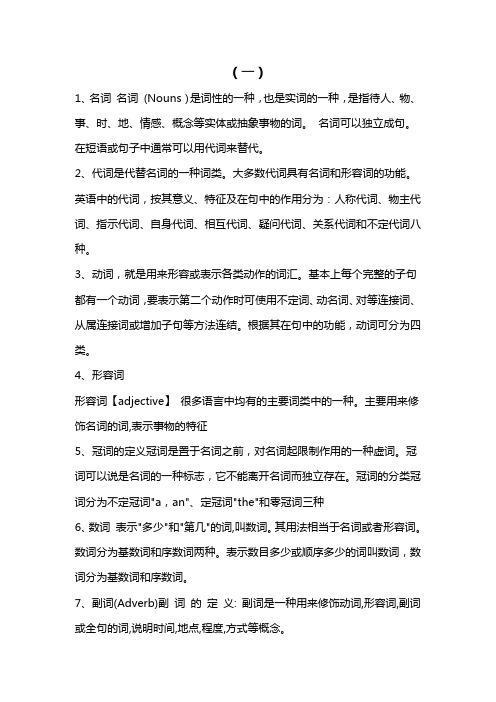
(一)1、名词名词(Nouns)是词性的一种,也是实词的一种,是指待人、物、事、时、地、情感、概念等实体或抽象事物的词。
名词可以独立成句。
在短语或句子中通常可以用代词来替代。
2、代词是代替名词的一种词类。
大多数代词具有名词和形容词的功能。
英语中的代词,按其意义、特征及在句中的作用分为:人称代词、物主代词、指示代词、自身代词、相互代词、疑问代词、关系代词和不定代词八种。
3、动词,就是用来形容或表示各类动作的词汇。
基本上每个完整的子句都有一个动词,要表示第二个动作时可使用不定词、动名词、对等连接词、从属连接词或增加子句等方法连结。
根据其在句中的功能,动词可分为四类。
4、形容词形容词【adjective】很多语言中均有的主要词类中的一种。
主要用来修饰名词的词,表示事物的特征5、冠词的定义冠词是置于名词之前,对名词起限制作用的一种虚词。
冠词可以说是名词的一种标志,它不能离开名词而独立存在。
冠词的分类冠词分为不定冠词"a,an"、定冠词"the"和零冠词三种6、数词表示"多少"和"第几"的词,叫数词。
其用法相当于名词或者形容词。
数词分为基数词和序数词两种。
表示数目多少或顺序多少的词叫数词,数词分为基数词和序数词。
7、副词(Adverb)副词的定义: 副词是一种用来修饰动词,形容词,副词或全句的词,说明时间,地点,程度,方式等概念。
8、介词的定义和特征介词是一种用来表示词与词, 词与句之间的关系的词。
在句中不能单独作句字成分。
介词后面一般有名词代词或相当于名词的其他词类,短语或从句作它的宾语。
(二)1、名词,人或事物的名称3、代词,代替名词或者数词(比如some就是代替数目)3、动词,动作或状态4、数词,表示数目或顺序(比如序数词,5th就是表示顺序)5、形容词,人或事物的性质或状态(因为形容词一般修饰名词)6、副词,动作的特征或性状特征(因为副词一般修饰动词或形容词)7、冠词,表示名词的泛指或特指8、介词,表示名词或代词与其他词的关系(因为介词后面一半紧跟名词,代词或其他名词性结构)9、连词,连接词与词,短语与短语,句子与句子10、感叹词,表示说话时的感情或语气(三)1、adj. / a. 形容词用来描述一类物质的性质,状态,外貌,或人的性格特点,性质,品格如:big,happy2、adv. / ad. 副词用来修饰动作或形容词,一般在句子中做状语用表示动作的进行怎样,或表示程度,特点,如:clearly,happily3、prep. 介词连接地点,时间的一类词语,可以表示方位,时间.跟一些表示时间,地点的词连用表示介词词组如:in,to,on,under4、conj. 连词用来连接时间,地点,原因,结果的一类词语如:when,beacuse,so5、num. 数词表示数字的词,既可以是基数词,也可以是序数词如:one,two,first6、int. 感叹词表示感叹的一类词,一般不加一解释,只代表感叹如:what,how,haurray7、vt. 及物动词(后面要加宾语)行为动作的词如:do,finish,play8、vi. 不及物动词(后面不加宾语)表示行为动作的词如:appear9、n. 名词表示物体,物质的词如:pig,cow,man10、pron. 代词代指一类人,事或物的词如:he,she,hers,his,things11、art = 冠词,article的缩写(四)在英语语法中主要把词分为8大类:1.名词:表示人、物或地方等,如:John,teacher;table,pen;London;beauty.2.代词:用来代替名词,以避免重复某个名词,如:I,you,it,that,those,them.3.形容词:用来修饰或限制某个(些)名词,如:good(man),white (paper),every(book),much(water),(John is)hon-est,(He seems)lazy.被修饰或限制的名词,叫做主体词(head-word)。
英语之中名词、代词、动词、形容词、冠词、数词、副词、介词、连词、感叹词
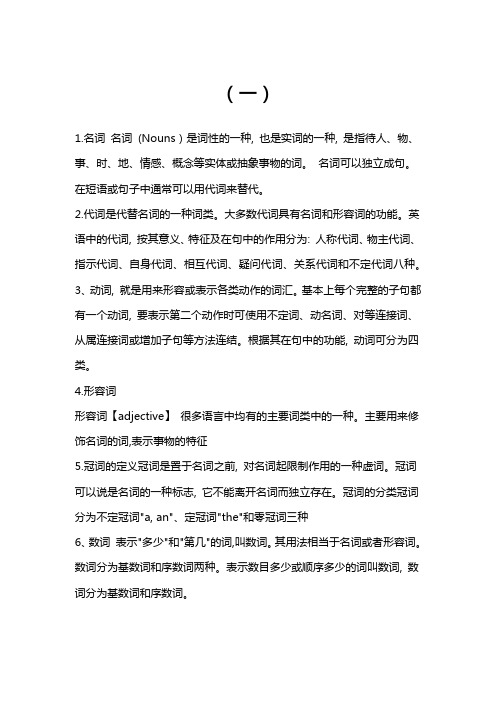
(一)1.名词名词(Nouns)是词性的一种, 也是实词的一种, 是指待人、物、事、时、地、情感、概念等实体或抽象事物的词。
名词可以独立成句。
在短语或句子中通常可以用代词来替代。
2.代词是代替名词的一种词类。
大多数代词具有名词和形容词的功能。
英语中的代词, 按其意义、特征及在句中的作用分为: 人称代词、物主代词、指示代词、自身代词、相互代词、疑问代词、关系代词和不定代词八种。
3、动词, 就是用来形容或表示各类动作的词汇。
基本上每个完整的子句都有一个动词, 要表示第二个动作时可使用不定词、动名词、对等连接词、从属连接词或增加子句等方法连结。
根据其在句中的功能, 动词可分为四类。
4.形容词形容词【adjective】很多语言中均有的主要词类中的一种。
主要用来修饰名词的词,表示事物的特征5.冠词的定义冠词是置于名词之前, 对名词起限制作用的一种虚词。
冠词可以说是名词的一种标志, 它不能离开名词而独立存在。
冠词的分类冠词分为不定冠词"a, an"、定冠词"the"和零冠词三种6、数词表示"多少"和"第几"的词,叫数词。
其用法相当于名词或者形容词。
数词分为基数词和序数词两种。
表示数目多少或顺序多少的词叫数词, 数词分为基数词和序数词。
7、副词(Adverb)副词的定义: 副词是一种用来修饰动词,形容词,副词或全句的词,说明时间,地点,程度,方式等概念。
8、介词的定义和特征介词是一种用来表示词与词, 词与句之间的关系的词。
在句中不能单独作句字成分。
介词后面一般有名词代词或相当于名词的其他词类, 短语或从句作它的宾语。
(二)1.名词, 人或事物的名称3.代词, 代替名词或者数词(比如some就是代替数目)3.动词, 动作或状态4.数词, 表示数目或顺序(比如序数词, 5th就是表示顺序)5.形容词, 人或事物的性质或状态(因为形容词一般修饰名词)6.副词, 动作的特征或性状特征(因为副词一般修饰动词或形容词)7、冠词, 表示名词的泛指或特指8、介词, 表示名词或代词与其他词的关系(因为介词后面一半紧跟名词, 代词或其他名词性结构)9、连词, 连接词与词, 短语与短语, 句子与句子10、感叹词, 表示说话时的感情或语气(三)1.adj./ a.形容词用来描述一类物质的性质,状态,外貌,或人的性格特点,性质,品格如:big,happy2.adv./ ad.副词用来修饰动作或形容词,一般在句子中做状语用表示动作的进行怎样,或表示程度,特点,如:clearly,happily3.prep.介词连接地点,时间的一类词语,可以表示方位,时间.跟一些表示时间,地点的词连用表示介词词组如:in,to,on,under4.conj.连词用来连接时间,地点,原因,结果的一类词语如:when,beacuse,so5.num.数词表示数字的词,既可以是基数词,也可以是序数词如:one,two,first6.int.感叹词表示感叹的一类词,一般不加一解释,只代表感叹如:what,how,haurray7、vt.及物动词(后面要加宾语)行为动作的词如:do,finish,play8、vi.不及物动词(后面不加宾语)表示行为动作的词如:appear9、n.名词表示物体,物质的词如:pig,cow,man10、pron.代词代指一类人,事或物的词如:he,she,hers,his,things11.art = 冠词, article的缩写(四)在英语语法中主要把词分为8大类:1. 名词: 表示人、物或地方等, 如: John, teacher;table, pen;London;beauty.2. 代词: 用来代替名词, 以避免重复某个名词, 如: I, you, it, that, those, them.3.形容词:用来修饰或限制某个(些)名词, 如:good(man), white (paper), every(book), much(water), (John is)hon-est, (He seems)lazy.被修饰或限制的名词, 叫做主体词(head-word)。
名词形容词动词副词
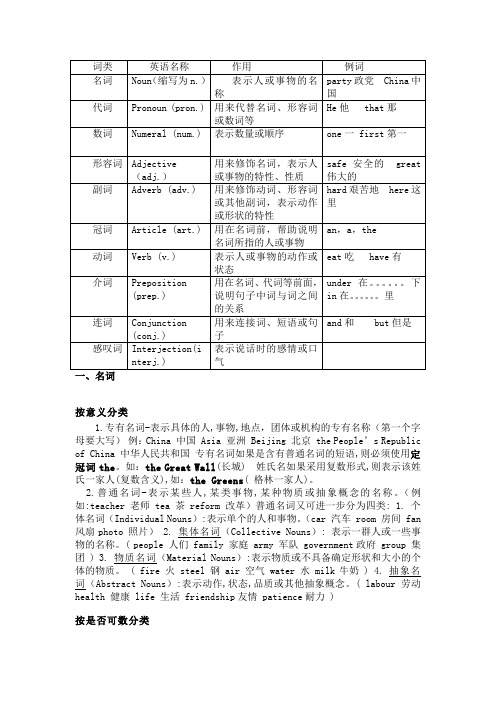
按意义分类 1.专有名词-表示具体的人,事物,地点,团体或机构的专有名称(第一个字母要大写) 例:China 中国 Asia 亚洲 Beijing 北京 the People’s Republicof China 中华人民共和国 专有名词如果是含有普通名词的短语,则必须使用定冠词the 。
如:the Great Wall (长城) 姓氏名如果采用复数形式,则表示该姓氏一家人(复数含义),如:the Greens ( 格林一家人)。
2.普通名词-表示某些人,某类事物,某种物质或抽象概念的名称。
(例如:teacher 老师tea 茶 reform 改革)普通名词又可进一步分为四类: 1. 个体名词(Individual (car 汽车 room 房间 fan风扇photo 照片)Collective Nouns ): 表示一群人或一些事家庭 army 军队 government 政府 group 集团Material Nouns ):火 steel 钢 air 空气 water 水 milk 牛奶Abstract Nouns ):表示动作,状态,品质或其他抽象概念。
健康 life 生活 friendship 友情 patience 耐力 )按是否可数分类名词又可分为可数名词(Countable Nouns)和不可数名词(Uncountable Nouns).不可数名词是指不能以数目来计算,不可以分成个体的概念、状态、。
抽象名词, 物质名词和专有名词一般是不可数名词. 可以分成个体的人或东西;因此它有复数形式名词的功能:名词在句中作主语, 宾语,介词宾语,宾语补足语,表语以及名词短语作状语。
1.主语:The bag is in the desk. 书包在桌子里边。
2.宾语:I washed my clothes yesterday. 昨天我洗了我的衣服。
3.表语:This is a good book. 这是一本好书。
英语怎么区分名词动词形容词和副词

英语怎么区分名词、动词、形容词和副词英语中的词性分类对于学习者来说是一个重要的基础知识点。
正确区分名词、动词、形容词和副词有助于我们更准确地理解和运用英语。
本文将介绍如何区分这四种常见的词性。
名词(Noun)名词是指表示人、动物、物体、地方、抽象概念等的词语。
在句子中通常作为主语、宾语、表语或定语。
名词的特点•名词可以用来表示生物、人、事物、地方、抽象概念等。
•名词一般可以加上冠词(如 a, an, the)或修饰性的形容词来具体描述或限定。
•名词可以以单数形式或复数形式出现。
名词的辨识方法•名词通常可以在句子中作为主语、宾语、表语或定语。
•名词通常可以在句子中使用冠词或限定词修饰。
•名词通常可以在句子中与动词一起构成主谓结构。
动词(Verb)动词是指表示行为、状态或存在的词语。
在句子中通常充当谓语,表示主语的动作或状态。
动词的特点•动词表示人或事物的动作、状态、发生的行为或存在的状态。
•动词可以根据不同的时态、语态、人称和数的不同形式变化。
动词的辨识方法•动词通常可以在句子中作为谓语。
•动词通常可以与名词或代词一起构成主谓结构。
•动词通常可以在句子中表达一个行为或状态。
形容词(Adjective)形容词是指用来修饰名词或代词的词语。
它可以提供更多关于名词或代词特征的信息。
形容词的特点•形容词可以用来描述或限定名词的特征、性质和状态。
•形容词通常在句子中位于名词前面或后面。
•形容词可以根据不同的程度变化。
形容词的辨识方法•形容词通常可以在句子中修饰一个名词。
•形容词通常可以与系动词(如 be, seem, feel)一起使用。
•形容词通常可以在句子中与名词一起构成主谓结构。
副词(Adverb)副词是指用来修饰动词、形容词、其他副词或整个句子的词语。
它可以提供更多关于动作、程度、方式、时间等的信息。
副词的特点•副词可以用来描述动作的方式、程度、时间、地点等。
•副词通常在句子中修饰动词、形容词或其他副词。
英语之中名词代词动词形容词冠词数词副词介词连词感叹词

一1、名词名词Nouns是词性的一种,也是实词的一种,是指待人、物、事、时、地、情感、概念等实体或抽象事物的词; 名词可以独立成句;在短语或句子中通常可以用代词来替代;2、代词是代替名词的一种词类;大多数代词具有名词和形容词的功能;英语中的代词,按其意义、特征及在句中的作用分为:人称代词、物主代词、指示代词、自身代词、相互代词、疑问代词、关系代词和不定代词八种;3、动词,就是用来形容或表示各类动作的词汇;基本上每个完整的子句都有一个动词,要表示第二个动作时可使用不定词、动名词、对等连接词、从属连接词或增加子句等方法连结;根据其在句中的功能,动词可分为四类;4、形容词形容词adjective 很多语言中均有的主要词类中的一种;主要用来修饰名词的词,表示事物的特征5、冠词的定义冠词是置于名词之前,对名词起限制作用的一种虚词;冠词可以说是名词的一种标志,它不能离开名词而独立存在;冠词的分类冠词分为不定冠词"a,an"、定冠词"the"和零冠词三种6、数词表示"多少"和"第几"的词,叫数词;其用法相当于名词或者形容词;数词分为基数词和序数词两种;表示数目多少或顺序多少的词叫数词,数词分为基数词和序数词;7、副词Adverb副词的定义: 副词是一种用来修饰动词,形容词,副词或全句的词,说明时间,地点,程度,方式等概念;8、介词的定义和特征介词是一种用来表示词与词, 词与句之间的关系的词;在句中不能单独作句字成分;介词后面一般有名词代词或相当于名词的其他词类,短语或从句作它的宾语;二1、名词, 人或事物的名称3、代词, 代替名词或者数词比如some就是代替数目3、动词, 动作或状态4、数词, 表示数目或顺序比如序数词,5th就是表示顺序5、形容词,人或事物的性质或状态因为形容词一般修饰名词6、副词, 动作的特征或性状特征因为副词一般修饰动词或形容词7、冠词, 表示名词的泛指或特指8、介词, 表示名词或代词与其他词的关系因为介词后面一半紧跟名词,代词或其他名词性结构9、连词, 连接词与词,短语与短语,句子与句子10、感叹词, 表示说话时的感情或语气三1、adj. / a. 形容词用来描述一类物质的性质,状态,外貌,或人的性格特点,性质,品格如:big,happy2、adv. / ad. 副词用来修饰动作或形容词,一般在句子中做状语用表示动作的进行怎样,或表示程度,特点,如:clearly,happily3、prep. 介词连接地点,时间的一类词语,可以表示方位,时间.跟一些表示时间,地点的词连用表示介词词组如:in,to,on,under4、conj. 连词用来连接时间,地点,原因,结果的一类词语如:when,beacuse,so5、num. 数词表示数字的词,既可以是基数词,也可以是序数词如:one,two,first6、int. 感叹词表示感叹的一类词,一般不加一解释,只代表感叹如:what,how,haurray7、vt. 及物动词后面要加宾语行为动作的词如:do,finish,play8、vi. 不及物动词后面不加宾语表示行为动作的词如:appear9、n. 名词表示物体,物质的词如:pig,cow,man10、pron. 代词代指一类人,事或物的词如:he,she,hers,his,things11、art = 冠词,article的缩写四在英语语法中主要把词分为8大类:1.名词:表示人、物或地方等,如:John,teacher;table,pen;London;beauty.2.代词:用来代替名词,以避免重复某个名词,如:I,you,it,that,those,them.3.形容词:用来修饰或限制某个些名词,如:goodman,whitepaper,everybook,muchwater,John ishon-est,He seemslazy.被修饰或限制的名词,叫做主体词head-word;4.动词:表示行为或状态,如:speak,read,go,think,is,seem.5.介词:表示它后面的名词或代词跟它前面的动词、另一名词或形容词的关系;这些名词或代词称为介词的宾语;介词宾语和介词构成介词短语;He went to school.介词to把名词school和动词went联系起来He stood by me.He asked for it.The book on the desk is mine.介词on把名词book和另一名词desk 联系起来He lives in a house on the mountain.他住在山上的一幢房子里;The bridge across this river is built by a Frenchman.河上的桥是一位法国人修建的;He is sure of it.他对此很有把握;of联系it和sure.It is good for you.这对你有好处;He is angry with Mary.他生玛丽的气;6.副词:修饰或限制动词、形容词或其他副词,乃至介词、连词及整个句子;He walked slowly.他走得很慢;He did it carefully.他干得很仔细;He is a very kind man.他是一个非常善良的人;John is truly honest.约翰的确很诚实;He arrived too late.他到得太晚了;He walked rather slowly.他走得相当慢;He sat far behind me.他坐在我后面挺远的地方;He arrived exactly at seven.他在7点整到达;He will come probably after we take lunch.他可能在我们吃午饭之后到达;He loves her just because she is pretty.他爱她只是因为她漂亮; Luckily,he got back his money.幸好他把钱要回来了; Historically,China is a great nation.从历史上看中国是个伟大的国家; 7.连词:用来连接词、词组短语或句子,如:and,but,or,so;或把一个句子和一动词或名词联系起来,如:when,because,as,though,that.He visited Hong Kong and Singapore.连词and把Hong Kong和Singapore连接起来他访问了香港和新加坡;She is pretty but cruel.她很漂亮却很残忍;He does exercise in class or at home.他在课堂上或是在家里做练习;or 把in class和at home两个短语连接起来She sat by me,reading novels but turning her eyes tochildren about her from time to time.她坐在我身旁看小说,但不时把眼睛转向她周围的孩子们;He works hard,so he will succeed.他很努力,所以他会成功;so把he works hard和he will succeed连接起来He says this and that,but he does not mean them.他说这说那,但这些都不是他的真心话;He was writing when it was rainning.下雨时他正在写作;when把动词was raining和he was writing连接起来He became a beggar because he had been a gambler.他成了乞丐因为他爱赌博;He went to school though he was sick.他虽病了,但他仍然上学; The news that the enemy had surrendered soon reached us.不久传来了敌人投降的消息;8.感叹词:用来表示说话时的感情,如Oh,Alas,My上面只是对8大词类粗略的解释;另外冠词、数词也可算作两个词类,冠词只有a,an,the3个字,数词可归入形容词中;。
英语之中名词代词动词形容词冠词数词副词介词连词感叹词

一1、名词名词 Nouns是词性的一种;也是实词的一种;是指待人、物、事、时、地、情感、概念等实体或抽象事物的词.. 名词可以独立成句..在短语或句子中通常可以用代词来替代..2、代词是代替名词的一种词类..大多数代词具有名词和形容词的功能..英语中的代词;按其意义、特征及在句中的作用分为:人称代词、物主代词、指示代词、自身代词、相互代词、疑问代词、关系代词和不定代词八种..3、动词;就是用来形容或表示各类动作的词汇..基本上每个完整的子句都有一个动词;要表示第二个动作时可使用不定词、动名词、对等连接词、从属连接词或增加子句等方法连结..根据其在句中的功能;动词可分为四类..4、形容词形容词adjective 很多语言中均有的主要词类中的一种..主要用来修饰名词的词;表示事物的特征5、冠词的定义冠词是置于名词之前;对名词起限制作用的一种虚词..冠词可以说是名词的一种标志;它不能离开名词而独立存在..冠词的分类冠词分为不定冠词"a;an"、定冠词"the"和零冠词三种6、数词表示"多少"和"第几"的词;叫数词..其用法相当于名词或者形容词..数词分为基数词和序数词两种..表示数目多少或顺序多少的词叫数词;数词分为基数词和序数词..7、副词Adverb副词的定义: 副词是一种用来修饰动词;形容词;副词或全句的词;说明时间;地点;程度;方式等概念..8、介词的定义和特征介词是一种用来表示词与词; 词与句之间的关系的词..在句中不能单独作句字成分..介词后面一般有名词代词或相当于名词的其他词类;短语或从句作它的宾语..二1、名词; 人或事物的名称3、代词; 代替名词或者数词比如some就是代替数目3、动词; 动作或状态4、数词; 表示数目或顺序比如序数词;5th就是表示顺序5、形容词;人或事物的性质或状态因为形容词一般修饰名词6、副词; 动作的特征或性状特征因为副词一般修饰动词或形容词7、冠词; 表示名词的泛指或特指8、介词; 表示名词或代词与其他词的关系因为介词后面一半紧跟名词;代词或其他名词性结构9、连词; 连接词与词;短语与短语;句子与句子10、感叹词; 表示说话时的感情或语气三1、adj. / a. 形容词用来描述一类物质的性质;状态;外貌;或人的性格特点;性质;品格如:big;happy2、adv. / ad. 副词用来修饰动作或形容词;一般在句子中做状语用表示动作的进行怎样;或表示程度;特点;如:clearly;happily3、prep. 介词连接地点;时间的一类词语;可以表示方位;时间.跟一些表示时间;地点的词连用表示介词词组如:in;to;on;under4、conj. 连词用来连接时间;地点;原因;结果的一类词语如:when;beacuse;so5、num. 数词表示数字的词;既可以是基数词;也可以是序数词如:one;two;first6、int. 感叹词表示感叹的一类词;一般不加一解释;只代表感叹如:what;how;haurray7、vt. 及物动词后面要加宾语行为动作的词如:do;finish;play8、vi. 不及物动词后面不加宾语表示行为动作的词如:appear9、n. 名词表示物体;物质的词如:pig;cow;man10、pron. 代词代指一类人;事或物的词如:he;she;hers;his;things11、art = 冠词;article的缩写四在英语语法中主要把词分为8大类:1.名词:表示人、物或地方等;如:John;teacher;table;pen;London;beauty.2.代词:用来代替名词;以避免重复某个名词;如:I;you;it;that;those;them.3.形容词:用来修饰或限制某个些名词;如:goodman;whitepaper;everybook;muchwater;John ishon-est;He seemslazy.被修饰或限制的名词;叫做主体词head-word..4.动词:表示行为或状态;如:speak;read;go;think;is;seem.5.介词:表示它后面的名词或代词跟它前面的动词、另一名词或形容词的关系..这些名词或代词称为介词的宾语..介词宾语和介词构成介词短语..He went to school.介词to把名词school和动词went联系起来He stood by me.He asked for it.The book on the desk is mine.介词on把名词book和另一名词desk 联系起来He lives in a house on the mountain.他住在山上的一幢房子里..The bridge across this river is built by a Frenchman.河上的桥是一位法国人修建的..He is sure of it.他对此很有把握..of联系it和sure.It is good for you.这对你有好处..He is angry with Mary.他生玛丽的气..6.副词:修饰或限制动词、形容词或其他副词;乃至介词、连词及整个句子..He walked slowly.他走得很慢..He did it carefully.他干得很仔细..He is a very kind man.他是一个非常善良的人..John is truly honest.约翰的确很诚实..He arrived too late.他到得太晚了..He walked rather slowly.他走得相当慢..He sat far behind me.他坐在我后面挺远的地方..He arrived exactly at seven.他在7点整到达..He will come probably after we take lunch.他可能在我们吃午饭之后到达..He loves her just because she is pretty.他爱她只是因为她漂亮.. Luckily;he got back his money.幸好他把钱要回来了..Historically;China is a great nation.从历史上看中国是个伟大的国家..7.连词:用来连接词、词组短语或句子;如:and;but;or;so;或把一个句子和一动词或名词联系起来;如:when;because;as;though;that.He visited Hong Kong and Singapore.连词and把Hong Kong和Singapore 连接起来他访问了香港和新加坡..She is pretty but cruel.她很漂亮却很残忍..He does exercise in class or at home.他在课堂上或是在家里做练习..or 把in class和at home两个短语连接起来She sat by me;reading novels but turning her eyes tochildren about her from time to time.她坐在我身旁看小说;但不时把眼睛转向她周围的孩子们..He works hard;so he will succeed.他很努力;所以他会成功..so把he works hard和he will succeed连接起来He says this and that;but he does not mean them.他说这说那;但这些都不是他的真心话..He was writing when it was rainning.下雨时他正在写作..when把动词was raining和he was writing连接起来He became a beggar because he had been a gambler.他成了乞丐因为他爱赌博..He went to school though he was sick.他虽病了;但他仍然上学.. The news that the enemy had surrendered soon reached us.不久传来了敌人投降的消息..8.感叹词:用来表示说话时的感情;如Oh;Alas;My上面只是对8大词类粗略的解释..另外冠词、数词也可算作两个词类;冠词只有a;an;the3个字;数词可归入形容词中..。
英语形容词和副词
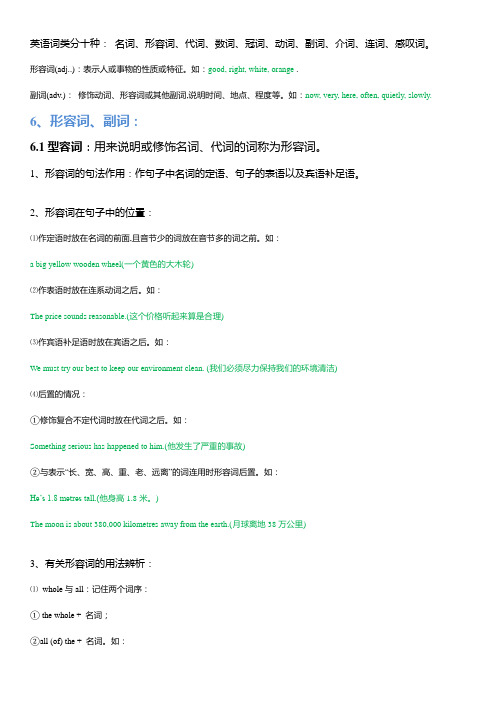
英语词类分十种:名词、形容词、代词、数词、冠词、动词、副词、介词、连词、感叹词。
形容词(adj..):表示人或事物的性质或特征。
如:good, right, white, orange .副词(adv.):修饰动词、形容词或其他副词,说明时间、地点、程度等。
如:now, very, here, often, quietly, slowly.6、形容词、副词:6.1型容词:用来说明或修饰名词、代词的词称为形容词。
1、形容词的句法作用:作句子中名词的定语、句子的表语以及宾语补足语。
2、形容词在句子中的位置:⑴作定语时放在名词的前面,且音节少的词放在音节多的词之前。
如:a big yellow wooden wheel(一个黄色的大木轮)⑵作表语时放在连系动词之后。
如:The price sounds reasonable.(这个价格听起来算是合理)⑶作宾语补足语时放在宾语之后。
如:We must try our best to keep our environment clean. (我们必须尽力保持我们的环境清洁)⑷后置的情况:①修饰复合不定代词时放在代词之后。
如:Something serious has happened to him.(他发生了严重的事故)②与表示―长、宽、高、重、老、远离‖的词连用时形容词后置。
如:He‘s 1.8 metres tall.(他身高1.8米。
)The moon is about 380,000 kilometres away from the earth.(月球离地38万公里)3、有关形容词的用法辨析:⑴whole与all:记住两个词序:① the whole + 名词;②all (of) the + 名词。
如:He was busy the whole morning.(整个早晨他都很忙)He can remember all the words he learns.(他能记住学过的所有单词)⑵tall与high, short与low:指人的个子时用tall与short;指其他事物时一般用high与low。
英语之中名词、代词、动词、形容词、冠词、数词、副词、介词、连词、感叹词
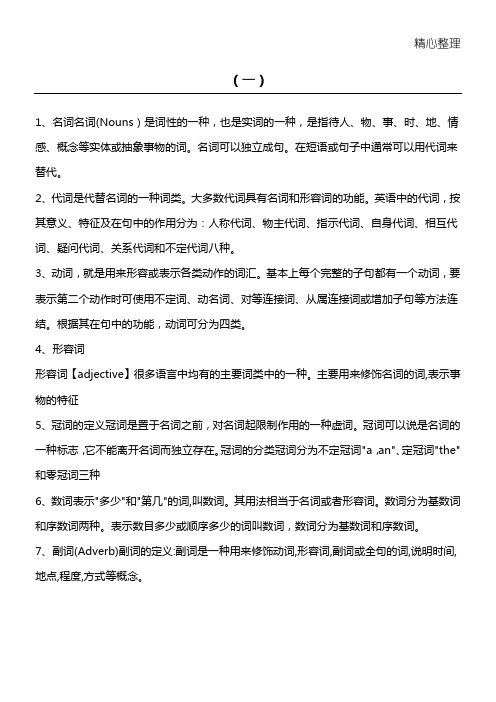
Johnistrulyhonest.约翰的确很诚实。
Hearrivedtoolate.他到得太晚了。
Hewalkedratherslowly.他走得相当慢。
Hesatfarbehindme.他坐在我后面挺远的地方。
Hearrivedexactlyatseven.他在7点整到达。
名词,代词或其他名词性结构)
9、连词,连接词与词,短语与短语,句子与句子
10、感叹词,表示说话时的感情或语气
(三)
1、adj./a.形容词
用来描述一类物质的性质,状态,外貌,
或人的性格特点,性质,品格
如:big,happy
2、adv./ad.副词
用来修饰动作或形容词,一般在句子中做状语用
表示动作的进行怎样,或表示程度,特点,
7、副词(Adverb)副词的定义:副词是一种用来修饰动词,形容词,副词或全句的词,说明时间,地点,程度,方式等概念。
8、介词的定义和特征介词是一种用来表示词与词,词与句之间的关系的词。在句中不能单独作句字成分。介词后面一般有名词代词或相当于名词的其他词类,短语或从句作它的宾语。
(二)
1、名词,人或事物的名称
Hewillcomeprobablyafterwetakelunch.他可能在我们吃午饭之后到达。
Helovesherjustbecausesheispretty.他爱她只是因为她漂亮。
Luckily,hegotbackhismoney.幸好他把钱要回来了。
Historically,Chinaisagreatnation.从历史上看中国是个伟大的国家。
4.动词:表示行为或状态,如:speak,read,go,think,is,seem.
名词副词形容词动词的使用

名词副词形容词动词的使用名词、副词、形容词和动词是英语语法中最基本的词类。
它们在句子中起着不同的作用,用来描述、修饰和表示各种概念。
在日常英语写作中,灵活运用这些词类能够使文章更加生动、丰富。
本文将探讨名词、副词、形容词和动词的使用,并提供一些实例,以帮助读者更好地理解和应用。
一、名词的使用名词是表示人、事物、概念或地点等具体或抽象对象的词语。
在句子中,名词可以作为主语、宾语、定语、表语和宾补等。
1. 主语:名词作为句子的主语,通常出现在句首,用来说明谁或者是什么在执行动作或发生情况。
例:Cars are everywhere in the city.(汽车在城市中无处不在。
)2. 宾语:名词作为句子的宾语,通常出现在动词或介词后,用来说明动作的承受者或者接受到动作的对象。
例:She loves reading books.(她热爱阅读书籍。
)3. 定语:名词作为句子的定语,用来修饰其他名词或代词,起到描述和区分的作用。
例:The blue sky is so beautiful.(蓝天很美丽。
)4. 表语:名词作为句子的表语,用来说明主语的状态或特征。
例:His dream is to become a doctor.(他的梦想是成为一名医生。
)5. 宾补:名词作为句子的宾补,用来补充说明宾语。
例:They elected him president.(他们选举他为总统。
)二、副词的使用副词是用来修饰动词、形容词、副词、短语或整个句子的词语。
它可以描述动作的方式、时间、地点、程度和频率等。
1. 描述动作方式:副词用来说明动作是如何进行或实现的。
例:She speaks English fluently.(她英语讲得很流利。
)2. 描述时间:副词用来表示动作发生的时间。
常见的时间副词有now(现在)、then(那时)、sometimes(有时)、often(经常)、always(总是)等。
例:He will arrive soon.(他很快就会到达。
英语名词,动词,副词,形容词的用法

英语名词,动词,副词,形容词的用法名词(Noun):1. 作为主语:名词通常用作句子的主语,表示是谁或是什么。
-例子:Cat is sleeping on the couch.2. 作为宾语:名词可以作为动词的宾语。
-例子:She loves her job.3. 所有格:名词可以使用撇号加's表示所有关系。
-例子:The dog's tail is wagging.动词(Verb):1. 谓语动词:动词通常用于表示动作或状态的谓语。
-例子:She runs every morning.2. 助动词:助动词与主动词一起使用,用于构成不同的时态、语态等。
-例子:He is playing football.3. 不定式:不定式是动词的一种形式,以'to'开头,通常用作动词的宾语。
-例子:I want to eat pizza.副词(Adverb):1. 修饰动词:副词通常用于修饰动词,表示如何进行动作。
-例子:She sings beautifully.2. 修饰形容词或副词:副词也可以修饰形容词或其他副词。
-例子:He is very tall.形容词(Adjective):1. 修饰名词:形容词通常用于修饰名词,描述名词的特征。
-例子:It's a beautiful day.2. 不定冠词后使用:形容词通常紧跟在不定冠词(a/an)之后,用于指代某一类事物。
-例子:I want an orange.这只是基本的概述,每种词类都有更多的细节和特殊用法。
深入学习英语语法时,可以参考语法书籍或在线语法资源。
英语之中名词、代词、动词、形容词、冠词、数词、副词、介词、连词、感叹词

英语之中名词、代词、动词、形容词、冠词、数词、副词、介词、连词、感叹词副词用来修饰动词、形容词或其他副词,表示时间、地点、方式、程度等概念。
如: slowly。
here3、___名词表示人、物、地点、时间、情感、概念等实体或抽象事物的词汇。
可独立成句,通常可以用代词替代。
如: book。
love4、___代词代替名词或数词的一种词类,具有名词和形容词的功能。
包括人称代词、物主代词、指示代词、自身代词、相互代词、疑问代词、关系代词和不定代词。
如: he。
their。
this5、v。
/ verb动词用来表示动作或状态的词汇,每个完整的子句都要有一个动词。
可使用不定词、动名词、对等连接词、从属连接词或增加子句等方法连结。
如: run。
think6、___数词表示数目或顺序的词汇,可用作名词或形容词。
分为基数词和序数词两种。
如: three。
fifth7、art。
/ article冠词置于名词前起限制作用的一种虚词,分为不定冠词"a,an"、定冠词"the"和零冠词。
如: a book。
the sky8、___介词用来表示词与词、词与句之间的关系的词汇,不能单独作句子成分。
后面一般有名词代词或相当于名词的其他词类、短语或从句作宾语。
如: in。
with9、___连词用来连接词与词、短语与短语、句子与句子的词汇。
如: and。
but10、int。
/ n感叹词表示说话时的感情或语气的词汇。
如: wow。
oh___ for you。
He is upset with Mary。
Adverbs modify or limit verbs。
adjectives。
other adverbs。
and even ns。
ns。
___ the task with great care。
He is an ___ kind individual。
John is ___ at seven o'clock。
英文形容词、副词。名词

英文形容词、副词。
名词英文形容词、副词和名词是英语语言中最基本的词性,它们经常被用来形容人、物、事物的特征,位置等。
本文将详细介绍英文形容词、副词、名词的特性和用法,帮助读者更好地应对英语语言学习和提高自己的英语水平。
一、英文形容词英文形容词是用来形容一个事物或者一个人的特征的,可以使文学作品更生动、具体。
形容词本身不具有语法性质,词义上的含义在名词或者代词之前来说明或强调该名词或者代词。
形容词的基本功能是让文本更具体,更准确地传递作者想要传达的信息。
例如:1. This is a beautiful painting. (这是一幅美丽的画。
)2. The blue sky makes me feel peaceful. (蓝天让我感到平静。
)3. The tired cat lay down on the soft rug. (疲惫的猫躺在软垫子上。
)注意:形容词必须接在名词的前面,不能放在名词和动词之间。
1. This is a painting beautiful. (错误)2. The sky blue makes me feel peaceful. (错误)3. The cat tired lay down on the rug soft. (错误)此外,英文形容词还有变化形式,包括原级、比较级和最高级等。
1. 原级:表示基本状态,如beautiful, happy等。
2. 比较级:用于表示两个事物之间的差异,如more beautiful(更美丽), happier(更快乐)等。
3. 最高级:表示三个及以上事物之间的差异,并强调最高程度的差异,如the most beautiful (最美丽的), the happiest(最快乐的)等。
二、英文副词英文副词是一个种独立的词性,与动词、形容词和其他副词配合使用以表示时间、地点、原因、结果等等概念。
在英语句子中,副词的位置通常位于动词之后或者后置方式出现在整个演讲或者句子的最后。
- 1、下载文档前请自行甄别文档内容的完整性,平台不提供额外的编辑、内容补充、找答案等附加服务。
- 2、"仅部分预览"的文档,不可在线预览部分如存在完整性等问题,可反馈申请退款(可完整预览的文档不适用该条件!)。
- 3、如文档侵犯您的权益,请联系客服反馈,我们会尽快为您处理(人工客服工作时间:9:00-18:30)。
英语中的名词副词形容词
副词
a. 表示程度:很、非常、极、十分、最、顶、太、更、挺、极其、格外、分外……
b. 表示范围:也、都、全、总、总共、共、统统、又、仅仅、只、光、净、一概……
c. 表示时间、频率:已经、曾经、早已、刚刚、正、正在、就、就要、将、将要、曾、刚、才、在……
d.表示肯定、否定:不、非、没、没有、不用(甭)、必、必须、必定、准、的确、未、别……
e. 表示情态、方式:忽然、猛然、公然、特意、亲自、大肆、肆意……
F. 表示语气:难道、决、岂、反正、也许、大约、大概、果然、居然、竟然、究竟……
g. 表示地点:家、这里、那里、每一处、楼上楼下、随时随地、无处不在、国外,在其他地……
定义:
副词是一种用来修饰动词,形容词,全句的词,说明时间,地点,程度,方式等概念。
分类:
1) 时间和频度副词:
now,then,often,always,usually,early,today, lately, next,last,already,generally,frequently, seldom,ever,never,yet,soon,too, immediately, hardly,finally,shortly, before, ago,sometimes, yesterday.
2) 地点副词:
here, there, everywhere, anywhere, in, out, inside, outside, above, below, down, back, forward, home, upstairs, downstairs, across, along, round , around, near, off, past, up, away, on.
3) 方式副词:
carefully, properly, anxiously, suddenly, normally, fast, well, calmly, politely, proudly, softly, warmly
4) 程度副词:
much,little, very,rather,so,too,still, quite, perfectly, enough, extremely, entirely,almost, slightly.
5) 疑问副词:
how, when, where, why.
6) 关系副词:
when, where, why.
7) 连接副词:
how, when, where, why, whether.
用法:
副词在句中可作状语,表语,补语。
He works hard.
他工作努力。
You speak English quite well.
你英语讲的很好。
Is she in ?
她在家吗?
Let's be out.
让我们出去吧。
Food here is hard to get.
这儿很难弄到食物。
副词(adverb)修饰动词、形容词和其他副词等,说明时间、地点、程度、方式等概念。
如:often往往,here这里,very很,quickly很快地。
一般来说:
1。
修饰动词的词语就是副词,如beat it heavily中的“heavily”就是副词,修饰“beat”,狠狠地打击。
2。
还有的副词是修饰形容词的,常常表示程度。
如extremely beautiful中的“extremely”修饰形容词“beautiful”,极其漂亮的
3。
还有的副词本身就是修饰副词,和修饰形容词类似。
4。
较特殊情况的副词可以放在句首,表一种伴随状态,
如“Fortunately,I managed it in time"中的fortunately。
幸运的,我最后及时的完成了(那件事情)
一、副词是一种用来修饰动词,形容词,副词或全句的词,说明时间,地点,程度,方式等概念。
副词在句中可作
状语,表语,短语。
一般的副词除固定副词外,其他副词加后缀-ly,但有些如ugly、friendly则不是副词。
分类:
1、时间和频度副词:
now,then,often,always,usually,early,today, lately, next,last,already,generally,frequently, seldom,ever,never,yet,soon,too, immediately, hardly,finally,shortly, before, ago,sometimes, yesterday.
2、地点副词:
here, there, everywhere, anywhere, in, out, inside, outside, above, below, down, back, forward, home, upstairs, downstairs, across, along, round , around, near, off,
past, up, away, on.
3、方式副词:
carefully, properly, anxiously, suddenly, normally, fast, well, calmly, politely, proudly, softly, warmly
4、程度副词,放在被修饰词之前:
much,little, very,rather,so,too,still, quite, perfectly, enough, extremely, entirely,almost, slightly.
5、疑问副词,一般放在句首:
how, when, where, why.
6、关系副词,一般放在句首:
when, where, why.
7、连接副词:
how, when, where, why, whether.
形容词(Adjective-a./adj.)形容词:表示事物的形状、性质和状态等
定义:直接或间接地用以修饰或限定名词或代词的词叫做形容词。
例如:
big(大的),tall(高的),good(好的),…
afraid(害怕的),glad(高兴的),…
many(很多的),some(一些的),no(没有),…
形容词的表达功能如下:
(1)直接修饰名词
一、名词概述
名词表示人、事物、地点或抽象概念等的名称。
英语名词可分为普通名词和专有名词两大
类。
普通名词包括:
1. 抽象名词(abstract nouns)。
如:beauty, fear, courage, charity, joy, etc.
2. 物质名词(material nouns)。
如:air, soap, beef, etc.
3. 集合名词(collective nouns)。
如:family, group, team, swarm, crowd, flock, etc.
4. 个体名词(individual nouns)。
如:table, man, dog, book, etc.
专有名词包括人名、地名等,如:Tom, Mrs. Smith, China, etc.
a good boy(一个好的男孩)
some beautiful flowers(一些美丽的花)
anything good(任何好的东西)
(2)间接修饰名词
例:Helen is a beautiful girl.
(海伦是一位美丽的女孩。
—直接修饰)
例:Helen looks very beautiful.
(海伦看起来很美。
—间接修饰)
注:“a,an,the”在文法上叫做冠词(Article),通常都归类在形容词。
“a,an”叫做不定冠词,用在可数名词之前,表示“单一”的意思,例如:a book(一本书)
a car(一辆轿车)
名词的首音若是元音就用“an”,例如:
an egg(一个蛋)
an American(一个美国人)
“the”叫做定冠词,表示“指定”的意思,例如:
the book on the desk(那张桌子上的那本书)
the cars they sell…(他们所卖的轿车……)。
